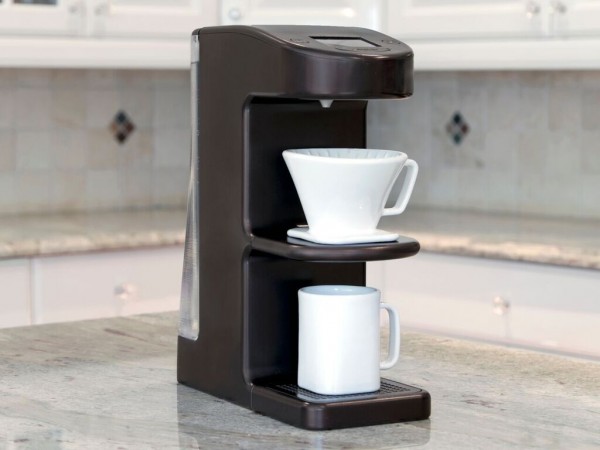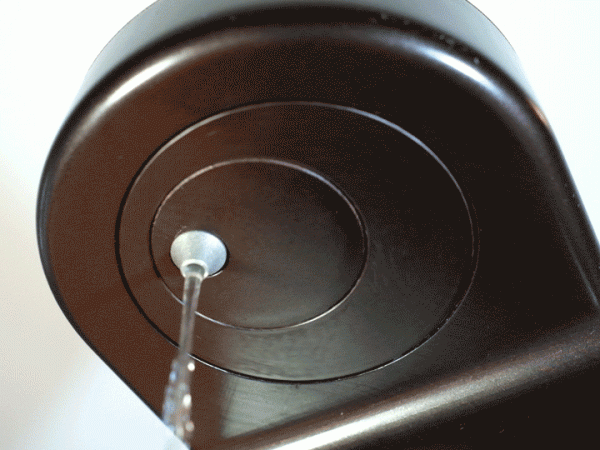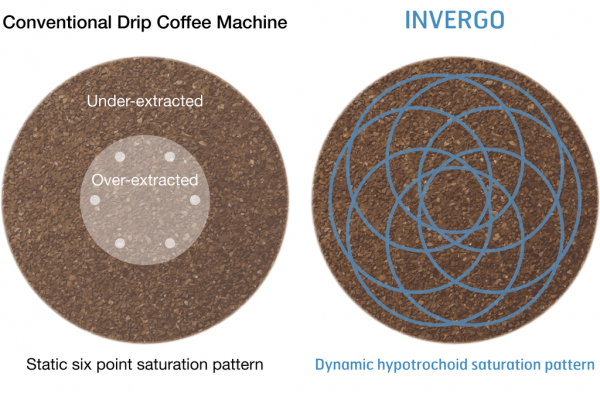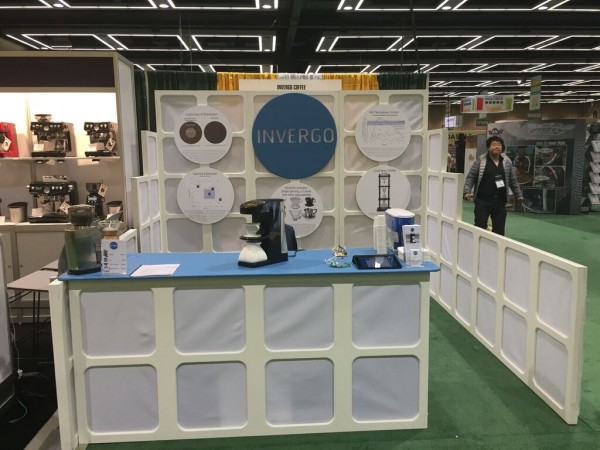Invergo Founder and Designer Cameron Hughes estimates he was roughly 12 when he first fell in love with coffee — the smell of it, anyway. The hot brown brew never seemed to taste as good as it smelled, until a few years later in high school when he discovered Café Grumpy.
“They make some really amazing coffee,” Hughes says, citing Grumpy’s Chelsea, N.Y., location, which opened his eyes and awakened his palate to the potential of coffee. Currently rounding the ripe old age of 21, Hughes has already wed his precocious love of excellent coffee to his appliance design acumen with the Invergo, an automated home pourover machine currently in pre-manufacturing and funded in part by a successful recent Kickstarter campaign.
The past few years have seen a spate of small drip brewing machines hit the home market that strive to automate manual pourover methods. A couple even come from the respected makers of classic manual pourover equipment, such as the Hario V60 Coffee King and the Chemex Ottomatic. Yet no machine currently available promises the same functionalities as the Invergo: Deliver water in a spiral — or in the Invergo’s case, “dynamic hypotrochoid” — pattern; customize the bloom and overall brewing time; set water temperature anywhere from 195-205F with PID control; adjust the volume of brewing from five to 50 fluid ounces; work with the user’s choice of vessel and cone; and start on a timer. It also has a slow-dripping cold brew function.
Other machines that promise this scope of functionality in the emerging automatic pourover race exist largely on the commercial front. Machines like the Otfes commercial spiral drip machine and the Poursteady, both of which, like the Invergo, made splashy appearances at the recent SCAA 2015 show in Seattle.
“I did look at that patent,” Hughes says of the Otfes, “and they use some sort of linear part for their gearing. I spoke to my lawyer and it’s definitely different from what we’re doing, so there shouldn’t be any problem with that.” He adds, “That machine’s also $6000.”
Consumers can currently pre-order the Invergo on Invergo’s website for $199.95. At such a home-friendly price point, it would seem to be smooth sailing ahead for the Invergo, although the seas to this point have been undeniably choppy from the winds of a tempestuous Kickstarter kickback.
The version of Kickstarter’s Terms of Use that was active at the time of the Invergo campaign’s launch made no requirement of explicit fiscal forthrightness on the part of a creator’s campaign. The Terms of Use were later updated to forbid any “material misrepresentations,” while the platform’s Creator Handbook has always clearly instructed, “Meeting your goal ensures that you’ll have the funds you need to complete your project and deliver rewards to your backers. Your funding goal should be the minimum amount needed to complete the project and fulfill rewards.”
Though the Invergo campaign remains governed only by the terms active at the time of its launch, it’s an awkward coincidence that the updated Terms of Use went into effect on October 19th, 2014, and Invergo’s fifth project update was posted on October 20th, which is exactly where things got a bit hairy.
Visible to backers only, the update was titled “SXSW and Opening Up Our Seed Round.” With the matter-of-fact manner of a routine briefing, it discussed an invitation to speak at SXSW and closed with a few lines about a search for angel investors. It candidly stated that without more money, Invergo would not be able to afford manufacturing, but that the successful Kickstarter campaign had provided the “traction” to take the important step of securing further capital.
Backers were upset. A heated comment-section melee promptly ensued. Speculation flurried. Accusations flew.
While most of Invergo’s communiques have been over a month apart, the sixth came just two days after the fifth, under the banner “Clarity and Transparency.” In it, Hughes — privately, for backers — provided a complete rundown of Invergo’s finances, expenses, and actual goals. “The reason we didn’t tell you about the external funding,” the update admitted, “is we honestly thought that because the goal was set relatively low that you would assume that the money from Kickstarter would not be the sole funding source. This is our mistake and we should have disclosed the need for additional capital in the Kickstarter.”
Some commenters appreciated the earnest, if belated, disclosure. Others felt only more justified in their condemnation of what was in their view a violation of Kickstarter rules and of the public trust.
What many backers were also putting together for the first time was that this was not the Invergo’s first whack at Kickstarter. It was no secret that in the fall of 2013, Hughes set a $250,000 fundraising goal on the project and failed, roping in just shy of $28,000, although to learn this you’d have to have done some clicking around. It was in the following summer that the project launched anew with a goal exactly one tenth the size of the original, setting the bar for success lower than what had already been achieved. This second campaign is what passed with flying colors, garnering the desired splash of positive press and three times as many backers as the first. It surpassed its modest goal by more than $10,000, yet it made no mention of the fact that without substantial additional funding, “The First Automated Pour Over Coffee System” would never see the light of day.
Tensions run high anywhere money and faith are involved. As such, crowdfunding services like Kickstarter and IndieGoGo are a dicey proposition no matter how you cut them. Aspirants put their projects and their good names on the line; patrons place their bets on products that don’t yet exist, as well as on individuals and companies that might also not be who they say they are. In return, backers expect a constant, detailed flow of total transparency, such as might be problematic for an inexperienced company navigating financial negotiations on the business front for the first time. And as noted in the recent New York Times article, “ZPM Espresso and the Rage of the Jilted Crowdfunder,” if backers get to a point of feeling crossed, things can take a dynamic hypotrochoidal nosedive in a hurry.
Creators, meanwhile, never know what sort of power or influence their backers might be capable of wielding should they be so inclined. Mark Prince, founder of the hugely popular coffee forum CoffeeGeek, is among the Invergo’s backers, for example. (Full disclosure: Howard Bryman, author of this article, is also a backer. Neither Bryman nor Roast Magazine benefit in any way, financially or with perks of any kind, in exchange for or as a result of this article.)
In the silence from Invergo that followed update number six, discontented backer Mark Prince decided to re-post the fifth and sixth updates, along with another very articulate backer’s reaction, publicly on Google Plus. Commenters started communicating with one another, apparently organizing towards retribution of some kind. Considering the crater still smoldering where the ZPM once brewed promise, the Invergo affair was on the precipice of true ugliness.
“It was totally my fault,” Hughes told Daily Coffee News in a recent phone conversation. “I didn’t understand what I was doing. It didn’t go well, with that. I did apologize to [the backers]. I should have been more transparent.”
But then a funny thing happened on Cameron’s way to the factory — nothing. While backers lamented — and continue to bemoan — a lack of communication, Cameron has continued his work on the Invergo. Machiavellian though the plan might seem to some, the good news is that it also seems to be working, and, at any rate, there’s no turning back. “Now we’re in a situation that [backers] are definitely going to get their units,” Hughes reports. “But I’m sorry for putting them in that position.”
There are huge and obvious differences between the ZPM debacle and Invergo’s missteps, chief among them being that Invergo is actually poised to cross the finish line and deliver. With ripples largely relaxed in the wake of his more heartening recent transmissions, Hughes has indicated some success in further fundraising and recalibrated the production plan to jibe with the reality of his resources. He did speak on a panel at SXSW and manned an Invergo booth at the SCAA Event, and through it all has been a full-time student of industrial design, interaction design, and entrepreneurship at Syracuse University. “I’m actually still in school,” says Hughes. “I’m doing both at the same time. It’s been very stressful.”
At the time of his last elucidation on Kickstarter, Hughes conveyed that beta units would be shipping in October. As of our conversation at the end of April, Hughes reported that the betas will actually ship sooner, although this news has yet to appear in an official Kickstarter update. The campaign’s promised delivery date was December, 2014; an actual delivery date less than one year later would, in Kickstarter time, still be a considerable success. The resolute Invergo helmsman took a few minutes from what can only be a mind-bending schedule to bring us up to date on all things Invergo. Here’s what he had to say.
How is Invergo doing today?
We’re doing well, we’re in pre-manufacturing right now. We’re finishing up with the second revision of the PCB and we’re almost done with the first initial tooling, so we’re going to send that off and it will take about 60 to 75 days to get the aluminum tooling done. We’re going to get about 50 units from that, and that’s going to be sent out to the UL for approval, as well as some beta testers that signed up.
How close is Invergo to having all the funds for a full-scale production run?
We have enough money to do the steel tooling and the first initial production run. That’s money that was not from Kickstarter. That was from other investors. Non-web-related channels. [The steel] tooling lasts up to 500,000 pieces each, but we’re only going to do an initial run of 5,000 pieces. We’re probably going to ship them actually in August, and the final units are going to be shipping in the end of the November. They’re going to be out for the holiday season — that’s what our plan is.
How did SXSW and SCAA go?
SXSW was nice. It was nice sharing my idea with a bunch of people. There was also a podcast that went really well. SCAA went really, really well. I feel like everyone that came up to the booth was really excited about the product. It was great to see people’s reaction when they used it and had a sample from it. Everyone left with a smile on their face, a few people gave me high-fives. There was actually a lot of interest from cafes, as well as from people for home use. Our plan for next year is to release a plumbed-in, NSF-certified version.
Do you think you’ll turn to Kickstarter again to fund the commercial Invergo?
No, we’re not. We designed the unit to be built modularly, so we just change out a few parts and the tooling process, and it’ll be ready for use in cafes.
How do feel about the way KS has gone for you this time around?
It’s been a little rough, communicating with my backers, because this has been like a personal thing as well as a business venture. I’m dealing directly with my customers, and it’s been really great getting their feedback, especially like when I did the PCB and I sent out the user interface. I sent out a working copy of the user interface that the backers could use, and they gave me their feedback on what they wanted changed and a few features that they wanted added, and I went right back and I was able to add that to the preproduction specifications for the unit. So that was actually really helpful. It’s been really helpful, but it’s also been a little bit difficult communicating with them.
To what do you attribute this difficulty in communication?
To this just being my first business venture and my not understanding how to deal with customers, and that’s been completely my fault. But I’ve been learning along the way, and I think now my communication skills with my backers are much better, and they’re really excited about getting the product.
Did you issue any refunds?
No one’s been asking for a refund now. I feel like I made up with them, and that they’re excited about the product now. They did ask for it, but once I clarified what’s going on and showed them our progress more transparently, they were excited about the project and they still want their coffee machine.
Any ideas for products that might follow the Invergo?
Actually I have quite a bit of ideas, for hardware, as well as some software. These will add some functionality, as well as some other coffee accessories, and different kinds of machines.
Is there going to be an Invergo app?
There might be. We are actually considering an online service that would be like a marketplace, for your coffee beans and the Invergo. Someplace where you can share your recipes with other users of the Invergo, so you can get the best possible extraction from the coffee that you’re using. Post the coffees you’ve gotten from different roasters, and then post the settings your using.
Any final thoughts?
I’m really excited about finally shipping it this winter.
Howard Bryman
Howard Bryman is the associate editor of Daily Coffee News by Roast Magazine. He is based in Portland, Oregon.
Comment
1 Comment
Comments are closed.










Just as state lotteries are a tax on people who can’t do math, crowdfunding is a tax on people who don’t understand business loans and venture investing.